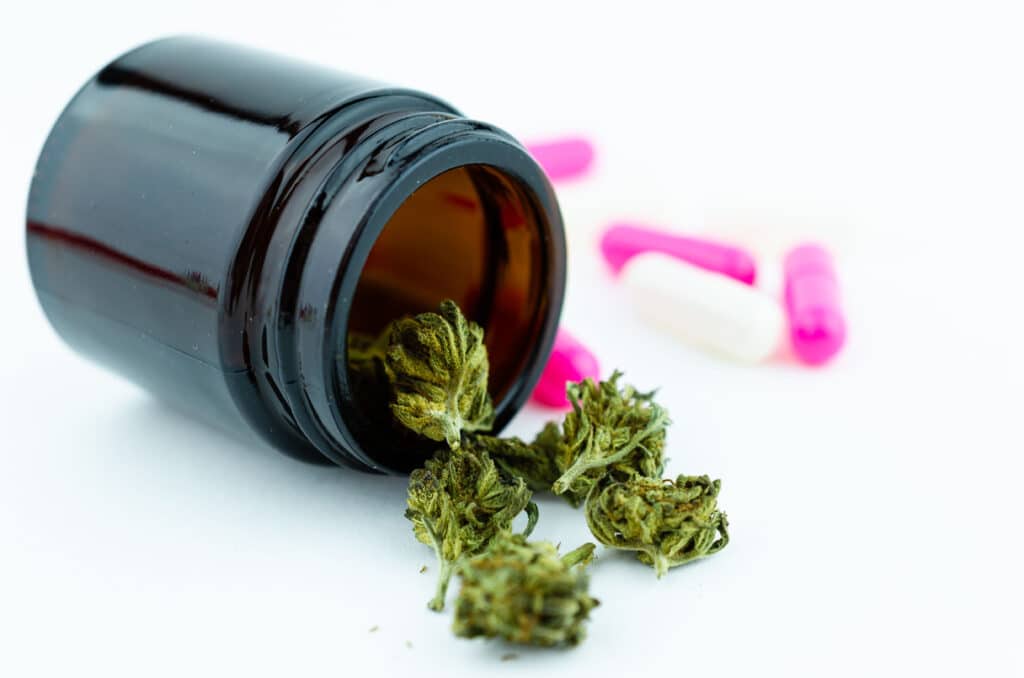addiction
(More) Research Indicates CBD Can Bring Down Opioid Use
Published
1 year agoon
By
admin
With an growing opioid overdose issue, you’d think anything that can help, would be used immediately. Recent research (again) ties CBD use with a decrease in opioid prescriptions.
New study on CBD and opioid prescriptions
The study in question, called CBD as a cure-all? The impacts of state-level legalization of prescription cannabidiol (CBD) on opioid prescriptions, was recently published in the Southern Economic Journal. Study researchers for the project came from Wofford College in South Carolina and California State University Bakersfield.
The study examined if state legalization for CBD products, had any affect on opioid prescribing rates; as well as if access through legal dispensaries had any effect on prescription rates. The first measure was country-wide, while the second was a look at the situation by state. The first relied on states with laws for limited access to cannabis products (laws which generally only enable the use of CBD); and the second, on states with general recreational and medical legalization laws that provide access to CBD products via dispensaries.
When looking at the first part, concerning limited access laws, the researchers found no difference in opioid prescribing rates. However, when looking at states that provide access through dispensaries, they found a 6.6% – 8.1% reduction in prescriptions for opioids. A synthetic control model estimate, approximated that there is a reduction of 3.5% in opioid prescribing, two years after a legalization.

The study found something else interesting, which might apply to more than just CBD. Study results indicate that once users are required to show an ID to buy CBD, or join a patient registry; that the decrease is offset. This indicates a strong desire of patients to maintain privacy; and a reticence to purchase certain products, if it violates that privacy.
Researchers brought there investigation down to a few conclusions concerning how availability of CBD changes opioid use/prescribing. The first is that requiring prescriptions to obtain CBD, does not help reduce opioid prescriptions at all. The second, is that anything that gets in the way of a purchase, like even an ID check, is enough to dissuade many buyers, even if it means not getting the help they need. And third, that if there is really desire to combat the opioid crisis, that easy access to CBD products (dispensaries and/or interstate purchasing ability), is necessary.
The opioid epidemic and why this matters
This is not a study looking at whether people like CBD; it’s a study that aims to establish if CBD is helpful in what is a staggering problem in the US. And so to be clear, before saying anything more, CBD comes with no death toll. If you’ve seen stories about issues with vapes, or tainted products, this is a different concern. Dirty or corrupted products are everywhere, in every industry. The compound of CBD itself, however, does not cause death. In fact, the most it causes negatively, is an uncomfortable couch lock feel for some. But it is unquestionably (and this is important) a non-death toll compound.
Opioids, on the other hand, are completely death toll compounds; and have led to a massive increase in overdose deaths, since their main arrival through the drug OxyContin, in the 1990’s. The opioid issue actually extends to pretty much every other drug class, as opioids are often mixed with most anything; from coke, to meth, to heroin, to alcohol. This means, not only have direct opioid deaths gone up; but deaths in all drug categories have risen, due to mixing with opioids.
In terms of numbers; the 2022 preliminary overdose death numbers for the US, which were released in May, give the number 109,680. There was less of an increase from 2021’s 109,179, than seen in the preceding years; although 109,179 is the updated number, and the preliminary one, was 107,622. This indicates the 2022 preliminary number, could also rise by the time it becomes the official number.
Though still a smaller increase from the previous years, its still an increase; and that means the problem is not getting any smaller, only bigger. 2021’s number, was a 15% increase from 2020’s 93,000 overdose deaths. And that number, went up 30% from the year before. 2019 had about 70,630 fatal overdoses from drugs.

Between 2019-2022, the overdose number went up 40%. 2018 had 67,367, which was actually lower than 2017’s 70,237. This is the only time recently that we’ve seen the trajectory change. Considering how quickly numbers picked up after this dip; it implies access to opioids shot up, or that the 2018 number might be representative of bad data collection and reporting.
These numbers represent all overdose deaths from all drug classes; not just opioids. In terms of the 2022 number, its expected that approximately 2/3 are related to synthetic opioids. This means, not codeine or heroin; but drugs like oxycodone, fentanyl, and other synthetic compounds that don’t exist in the opium plant, and are considerably stronger than the offerings of previous decades, centuries, and millennia.
Heroin – what used to be the be-all-end-all of drug use, has had relatively consistent overdose death numbers for over 20 years, despite many reports that it spiked up around 2010. You can see from the attached graph, this notion was a bit of an overstatement; and probably just a means of shifting focus from the growing synthetic opioid epidemic, which was already taking off.
Is this the first time we’ve heard CBD can help with opioids?
No, not even close. This conversation has been going on even before CBD was legalized through the 2018 US Farm Bill. The reason is that CBD can reduce addiction anxiety, partly by deactivating opioid receptors. It can also decrease pain issues by working as an anti-inflammatory, and by blocking pain signals to the brain.
And its been bringing down opioid use numbers for many years. A 2014 study out of Johns Hopkins Bloomberg School of Public Health, in conjunction with the Philadelphia Veterans Affairs Medical Center, showed that medical cannabis states had prescription drug death rates 25% lower than in states with medical cannabis allowances. According to the study, states with medical cannabis laws, had approximately 1,700 less yearly deaths from opioids, as of 2010.
Both CBD, and cannabis in general, are cited for their ability to bring down opioid use. As cannabis as a whole (including THC) still has no direct death toll attached, we are once again automatically comparing something that kills no one, to drugs that kill close to 100,000 people a year in the US alone. This should always be remembered when there are fear campaigns in the US over cannabis.

In terms of cannabis as a whole, this 2022 study indicates the plant can bring down opioid use, and that its not just about CBD. This study, entitled Medical Cannabis Patients Report Improvements in Health Functioning and Reductions in Opiate Use, used a self-report method to evaluate how cannabis use affects opioid taking.
According to study results, a majority of 79% said they used less other pain medication, or stopped using all other pain medications completely, when using medical cannabis. Many (11.4%) said they had improved functionality in life. About 9% of the included participants only had a pain issue, while 49.92% reported pain along with a mental health issue.
Cannabis has been cited as a feasible answer to opioid addiction for so long; that its weird its not pushed by the federal government to deal with the opioid crisis, and that it gets pushback at all. If the idea is to really help people, shouldn’t they get helped? Even if it doesn’t work for a person, or if it only helps some people; the fact that it’s a safe option up against medicines understood to be taking lives by the tens of thousands, makes it silly that we have to make a case for it at all.
Any government lines of ‘concern,’ are shot to hell by the fact that these ‘concerns’ (over things like disproved smear-campaign theories that cannabis promotes psychosis); run alongside over 100,000 deaths a year from drug overdoses. Maybe those deaths should be the ‘concern,’ not a plant that has a chance of helping the problem.
And for that matter, what about ketamine?! CBD and cannabis, can probably help a lot of people. But the harsh reality, is that neither is likely enough for extreme pain issues. However, ketamine is; and much like weed, it offers an answer that comes without a death toll. Once again, any fear complaints about the drug, are gravely misplaced considering that any non-death toll drug (with minimal injury attached), is automatically a better option to a known killer. Yet despite this basic logic; nearly all information on ketamine for pain relief, is so badly suppressed that most people have no idea its an option at all.
Conclusion
The second there was an inkling that a compound like CBD could help with opioid addictions (or cannabis or ketamine); it should have been used immediately, to lower opioid use rates. That we still have to argue about non-lethal compounds while people die left and right; is not a good indication of what we can expect from governments or medical systems, in terms of taking real action. You’re best bet if you’re in the situation of dealing with pain, and don’t want opioids? Do the research, get the products (or sign up for the programs), and get yourself the help you need.
Welcome cannabis fans. We appreciate your patronage at Cannadelics.com; an independent publication in the weed scene, reporting on the biggest stories of today. We’ve got daily updates, so join us frequently; and sign up to our Cannadelics Weekly Newsletter; for all the best news and promos, right to your email.
Related
You may like
addiction
Can Psychedelics Treat Addiction and Alcoholism?
Published
6 months agoon
September 13, 2024By
admin
Psychedelics, once associated primarily with counterculture and recreational drug use, are now being seriously studied for their therapeutic potential in treating drug addiction and alcoholism. Recent research has shown that substances like psilocybin, LSD, and ayahuasca may have profound benefits for individuals struggling with Alcohol Use Disorder (AUD) and substance use disorders (SUD). These compounds are being reconsidered not only for their ability to induce altered states of consciousness but also for their potential to address addictive behaviors and psychological trauma at the root of addiction.
Psilocybin’s Efficacy in Treating Alcohol Use Disorder
One groundbreaking study, conducted at New York University and Johns Hopkins University, demonstrated the potential of psilocybin in treating Alcohol Use Disorder (AUD). The researchers focused on individuals with severe AUD, administering two doses of psilocybin in conjunction with psychotherapy. The results were notable: participants reported a 50% reduction in heavy drinking days over an eight-month period, with some maintaining abstinence from alcohol even a year later.
The trial followed a double-blind, randomized approach and found that the therapeutic effects of psilocybin were superior to those observed with placebo treatments. Dr. Michael Bogenschutz, a lead researcher in the study, emphasized the importance of the psychedelic experience itself in breaking the cycle of addiction. Psilocybin appears to help patients break through entrenched mental patterns, often revealing deeper emotional connections and realizations that drive more meaningful behavior change.
How Psychedelics Influence the Brain to Combat Addiction
The mechanism behind the efficacy of psychedelics in treating addiction is thought to involve neuroplasticity, or the brain’s ability to reorganize and form new connections. By interacting with serotonin 2A receptors, particularly in the prefrontal cortex and default mode network, psychedelics can enable profound shifts in perception and cognition. These altered states of consciousness allow individuals to confront underlying psychological issues, such as trauma or negative emotional patterns, which are often at the core of addictive behaviors.
Many individuals undergoing psychedelic-assisted therapy report experiencing a “reset” of their mental state, facilitating a more open mindset that helps them engage with therapy in a deeper, more effective way. This contrasts with traditional addiction treatments, such as methadone or buprenorphine, which primarily manage withdrawal symptoms but do not address the psychological components of addiction.
LSD and Its Potential in Addiction Treatment
LSD (lysergic acid diethylamide) has also shown promise in treating addiction, particularly alcoholism. Early studies from the 1950s to the 1970s suggested that LSD might help reduce alcohol dependency, but interest in this line of research waned due to regulatory crackdowns on psychedelic research. However, more recent studies have reignited interest in LSD’s therapeutic potential.
A meta-analysis published in the Journal of Psychopharmacology reviewed data from six trials involving over 500 patients. It concluded that a single high dose of LSD, administered in a therapeutic setting, was associated with a significant reduction in alcohol consumption. The study found that LSD’s psychedelic effects could lead to lasting changes in personality traits, such as openness and emotional resilience, which are crucial for overcoming addiction.
Ayahuasca and Addiction Recovery
Ayahuasca, a traditional Amazonian brew containing DMT (dimethyltryptamine) and MAO inhibitors, has been the focus of recent studies examining its potential to treat addiction. Researchers have found that ayahuasca’s intense psychoactive properties, combined with its ability to facilitate introspection and emotional healing, may help individuals overcome opioid and stimulant addiction. A study published in Frontiers in Pharmacology noted that ayahuasca led to significant improvements in mental health and reductions in addictive behaviors.
Ayahuasca ceremonies, often conducted in a spiritual context, have been shown to promote healing through vivid and sometimes challenging visions. Participants often report gaining insights into the underlying causes of their addiction, leading to long-lasting psychological benefits.
Challenges in Psychedelic-Assisted Therapy
While the results of these studies are promising, the use of psychedelics in treating addiction is not without challenges. For one, the psychedelic experience itself can be unpredictable, and not all patients experience the profound mystical or emotional breakthroughs associated with positive outcomes. The effectiveness of psychedelic-assisted therapy appears to be linked to the quality of the therapeutic environment and the expertise of the facilitators, meaning that careful preparation and integration are key to success.
Moreover, while psychedelics like psilocybin and LSD do not appear to be physically addictive, their use must still be carefully regulated to prevent potential psychological risks, such as hallucinations, anxiety, or psychotic episodes in vulnerable individuals. Current research emphasizes the need for controlled settings where trained therapists can guide patients through their psychedelic experiences.
Ongoing Research and Future Directions
Given the promising early results, psychedelic research is entering a new phase, with larger clinical trials currently underway. The National Institutes of Health (NIH) recently allocated $2.4 million to explore the use of psychedelics in treating methamphetamine addiction, further solidifying the role of psychedelics in addiction therapy. Similarly, ongoing studies are looking into psilocybin’s potential to treat opioid addiction and cocaine dependence, conditions that have been notoriously difficult to treat with conventional methods.
As research progresses, it is likely that psilocybin, LSD, and other psychedelics will become more widely recognized as effective tools for addiction treatment. While more research is needed to fine-tune these therapies and better understand their long-term effects, early indications are that psychedelics could revolutionize addiction and alcoholism treatments in the coming decades.
Conclusion
Psychedelics like psilocybin, LSD, and ayahuasca are emerging as potential breakthrough therapies for treating drug addiction and alcoholism. By promoting neuroplasticity and addressing the psychological roots of addiction, these substances offer an alternative to traditional addiction treatments, which often focus on managing symptoms rather than curing the disease. With ongoing research and increasing clinical trials, psychedelic-assisted therapy may become an essential tool in the fight against substance use disorders, offering hope to millions of people who struggle with addiction, such as alcoholism.
Sources
Johns Hopkins Medicine: Psychedelics in Addiction Treatment
Progress in Neuro-Psychopharmacology and Biological Psychiatry
National Institutes of Health (NIH) Research on Psychedelics
Frontiers in Pharmacology: Ayahuasca for Addiction Recovery
JAMA Otolaryngology – Head & Neck Surgery
Related
addiction
The Evolving Opioid Crisis in Europe: Heroin and Synthetic Threats
Published
6 months agoon
September 12, 2024By
admin
The opioid crisis in Europe is growing in complexity, with heroin continuing to dominate the market while synthetic opioids, such as fentanyl and its analogs, emerge as potent new threats. The 2024 EU Drug Markets Report, released by the European Monitoring Centre for Drugs and Drug Addiction (EMCDDA) and Europol, provides a comprehensive analysis of the heroin and synthetic opioid market, detailing the health risks, evolving trafficking routes, and potential future challenges.
Heroin in Decline? Why Synthetic Opioids Pose a New Threat in Europe
Heroin’s Ongoing Impact in Europe
Heroin remains the most commonly used illicit opioid in Europe, with an estimated 1 million high-risk opioid users. The European heroin market is valued at over €5.2 billion annually, indicating the persistent demand for this drug. In 2021, EU countries seized 9.5 tonnes of heroin, the largest quantity in 20 years. These figures underscore the strong presence of heroin in Europe, despite the introduction of harm reduction programs aimed at curbing opioid use.
The health consequences of heroin use are severe. In 2021, opioids were responsible for three-quarters of Europe’s 6,000 drug-related overdose deaths, with heroin being a leading factor. Long-term users are aging, adding complexity to public health strategies, as older opioid users present with more chronic health problems.
Afghanistan’s Opium Ban: Future Implications for Heroin Supply
Nearly all heroin consumed in Europe is derived from opium produced in Afghanistan. However, Afghanistan’s opium production has seen a dramatic decline following the Taliban’s 2022 ban on poppy cultivation, which led to a 95% reduction in production by 2023. While the immediate impact on heroin availability in Europe has been minimal, the report warns that a sustained ban could lead to future heroin shortages. Such shortages could open the door for synthetic opioids to dominate the market.
The decline in Afghan opium cultivation from 233,000 hectares in 2022 to just 10,800 hectares in 2023 has raised concerns about the future of heroin availability in Europe. Should the Taliban continue to enforce the ban, experts believe the resulting heroin scarcity could increase the use of more potent and dangerous synthetic opioids, exacerbating the public health crisis.
The Rise of Synthetic Opioids: Fentanyl and its Analogues
Synthetic opioids, such as fentanyl, are becoming more prevalent in the European drug market. These substances are far more potent than heroin, and even small doses can lead to fatal overdoses. The 2024 report highlights how these synthetic opioids are contributing to a growing number of overdose deaths and hospital emergencies across Europe. In countries such as Estonia and Sweden, fentanyl is responsible for a significant proportion of drug-related deaths.
Fentanyl analogs are particularly concerning because they can be mixed with other drugs like heroin or cocaine, often without the user’s knowledge. The increasing presence of these synthetic opioids is a major public health concern, as traditional harm reduction measures, such as naloxone distribution and needle exchange programs, are less effective against these more potent substances.
Changing Trafficking Routes and Criminal Networks
Traffickers are increasingly adapting their methods in response to heightened enforcement measures and geopolitical developments. The traditional Balkan route, which brings heroin through Turkey and Bulgaria into Europe, has seen increased enforcement and stricter border controls, prompting traffickers to shift towards alternative routes.
The Southern route is becoming more prominent, with significant heroin shipments passing through Iran and Pakistan before reaching Europe via major seaports. The United Arab Emirates (UAE) has emerged as a key transshipment hub for heroin, providing both logistical support and avenues for money laundering. Meanwhile, the ongoing Russia-Ukraine war has prompted criminal networks to modify their trafficking routes, further complicating law enforcement efforts.
Public Health and Harm Reduction Efforts
Harm reduction strategies have had some success in mitigating the impact of opioid use in Europe. Programs such as opioid substitution therapy (OST) and needle exchange have helped reduce the number of new users injecting heroin, thereby lowering the risks of HIV and hepatitis C transmission. However, the growing prevalence of synthetic opioids poses new challenges. These potent drugs often require stronger overdose prevention measures, such as fentanyl test strips and more widespread access to naloxone, an opioid antagonist used to reverse overdoses.
Additionally, the report notes the importance of expanding data collection and improving early warning systems to monitor emerging trends in opioid use and trafficking. These systems allow public health authorities and law enforcement to respond more quickly to new synthetic opioids entering the market.
Challenges in Treating Opioid Addiction
Treatment for opioid addiction, particularly heroin, is evolving. Europe’s aging population of opioid users presents new challenges, as older users are more likely to have complex medical conditions. Many long-term users require not just drug treatment but also social support and healthcare for chronic conditions related to long-term substance use. Furthermore, gender-specific issues are emerging, as women who use opioids face more barriers to accessing treatment and are more likely to present with co-occurring psychological or social issues.
Conclusion
The opioid crisis in Europe is evolving, with heroin still posing a significant threat to public health, while synthetic opioids like fentanyl are emerging as an even more dangerous force. The reduction in Afghan opium production and the shifting trafficking routes complicate the landscape further. To tackle this complex issue, Europe must continue to invest in harm reduction, international cooperation, and early warning systems to prevent more overdose deaths and manage the changing face of the opioid market. Without a coordinated response, Europe risks facing an even more devastating public health crisis in the coming years.
Related

The fact that some people are eating dogs and cats is a highly sensitive topic that crosses cultural, social, and ethical boundaries. In many regions, these animals are consumed due to cultural traditions and necessity, while in other cases, drug-induced behavior may lead individuals to engage in extreme or unusual dietary practices. This article aims to explore the distinction between cultural norms and the desperate, erratic behaviors driven by substance abuse, focusing on the need for cultural sensitivity while addressing harmful behavior.
When Culture Meets Addiction: Who Is Eating Dogs and Cats?
Cultural Practices and the Consumption of Non-Traditional Animals
In some parts of Asia and Africa, the phenomena of eating dogs and cats has historical roots that are tied to both cultural traditions and the availability of resources. In these regions, the eating of non-traditional animals is a normalized practice and is not connected to drug-fueled behavior.
- Cultural Normalcy: In regions such as South Korea, China, and Vietnam, dogs have historically been consumed as part of traditional cuisines. This practice is not driven by addiction or desperation but by cultural norms that view these animals as a food source rather than pets.
- Food Scarcity: In some communities, especially in impoverished or rural areas, consuming non-traditional animals like dogs or cats is a practical response to food scarcity. The decision to eat these animals is based on survival rather than personal preference or altered judgment.
Drug-Induced Dietary Choices: When Addiction Leads to Extreme Behaviors
In contrast to cultural practices, there are cases where individuals under the influence of drugs engage in extreme or bizarre behaviors, such as eating dogs and cats… This behavior is driven by impaired judgment, psychosis, or desperation caused by addiction, and often occurs in isolated or marginalized communities.
- Methamphetamine and Erratic Behavior: Meth users are known to exhibit extreme and irrational behaviors, including eating animals they wouldn’t normally consider food. Meth-induced psychosis can blur the lines between reality and hallucination, leading to bizarre dietary choices such as consuming pets or strays.
- Desperation from Heroin Addiction: Heroin addicts, especially those living in extreme poverty, may consume non-traditional animals out of necessity. Chronic malnutrition and impaired judgment, combined with isolation from society, can drive addicts to make choices they wouldn’t otherwise consider.
Understanding the Cultural vs. Drug-Fueled Divide
It’s crucial to differentiate between cultural practices and behaviors driven by addiction when discussing the consumption of non-traditional animals. Respecting cultural practices while addressing the harmful impacts of substance abuse requires a nuanced understanding of these different contexts.
- Cultural Sensitivity: When discussing the consumption of non-traditional animals, especially in regions where this practice is accepted, it is important to approach the subject with cultural sensitivity. Condemning these practices without understanding their historical and social context can perpetuate stereotypes and breed intolerance.
- Addressing Addiction-Related Behaviors: Conversely, when the consumption of animals like dogs and cats is tied to addiction, the focus should be on treating the root causes of drug abuse rather than criminalizing individuals. Rehabilitation, mental health support, and access to food resources are critical in preventing desperate behaviors.
Ethical Considerations and Animal Welfare
Regardless of whether the consumption of non-traditional animals is driven by culture or desperation, the ethical treatment of animals is a key concern. The dog and cat meat industries have come under scrutiny for their inhumane treatment of animals, and organizations worldwide are working to promote animal welfare and ethical eating practices.
- Animal Rights in Cultural Contexts: While respecting cultural traditions, animal rights organizations are increasingly advocating for more humane practices within these industries. Campaigns to ban or reduce the consumption of dog and cat meat have gained traction, with a focus on reducing cruelty and promoting alternative food sources.
- Animal Cruelty and Drug Addiction: In cases of drug-induced behaviors, the animals involved often suffer from neglect or harm. Providing support for addicts and ensuring animals are removed from harmful environments can help mitigate this issue.

How to Approach the Issue Globally
Addressing the issue of non-traditional animal consumption, whether cultural or drug-fueled, requires a global approach that balances respect for cultural practices with the promotion of humane treatment for animals. Public health initiatives and cultural sensitivity training can help bridge the gap between different viewpoints while ensuring that animals and people alike are treated with dignity.
- Promoting Cultural Understanding: Efforts to educate the public on the cultural contexts of eating non-traditional animals can help reduce prejudice and promote more respectful global dialogues. Cultural exchange programs and educational campaigns can provide a more nuanced view of these practices.
- Addressing Substance Abuse: On the other hand, combatting the desperation and irrational behavior caused by addiction requires investments in mental health, addiction treatment, and public welfare systems. Providing addicts with support, housing, and access to food can reduce the likelihood of harmful or extreme behaviors.
Conclusion
While the consumption of non-traditional animals like dogs and cats may be culturally accepted in some regions, drug-induced behaviors that lead to similar actions must be understood in a different light. It’s important to address addiction-related behavior with compassion, focusing on rehabilitation and support rather than punishment. At the same time, promoting animal welfare and humane practices in regions where these animals are consumed can create a more ethical global community. By approaching these issues with respect for cultural diversity and a commitment to reducing harm, both animals and humans can benefit.
Related

Food Asphyxiation Is Way More Dangerous Than Cannabis

Outdoor Marijuana Grows Are Better All The Way Around

Shop 50% off at Story Cannabis this 420

Rolling Releaf: 420 deals delivered – all April long

Shop local this 420 at Simply Pure

25% off award-winning seeds from Fast Buds for 420

Skip the crowds and start your 420 early with nuEra
Tap into 420 and snag the best deals at Sesh NYC

Celebrate 420 with new deals throughout the week at Lionheart Cannabis

Make 420 mega with 30% off from Grön

Distressed Cannabis Business Takeaways – Canna Law Blog™

United States: Alex Malyshev And Melinda Fellner Discuss The Intersection Of Tax And Cannabis In New Video Series – Part VI: Licensing (Video)

What you Need to Know

Drug Testing for Marijuana – The Joint Blog

NCIA Write About Their Equity Scholarship Program

It has been a wild news week – here’s how CBD and weed can help you relax

Cannabis, alcohol firm SNDL loses CA$372.4 million in 2022

A new April 20 cannabis contest includes a $40,000 purse

Your Go-To Source for Cannabis Logos and Designs

UArizona launches online cannabis compliance online course
Trending
-

 Cannabis News2 years ago
Cannabis News2 years agoDistressed Cannabis Business Takeaways – Canna Law Blog™
-

 One-Hit Wonders2 years ago
One-Hit Wonders2 years agoUnited States: Alex Malyshev And Melinda Fellner Discuss The Intersection Of Tax And Cannabis In New Video Series – Part VI: Licensing (Video)
-

 Cannabis 1012 years ago
Cannabis 1012 years agoWhat you Need to Know
-

 drug testing1 year ago
drug testing1 year agoDrug Testing for Marijuana – The Joint Blog
-

 Education2 years ago
Education2 years agoNCIA Write About Their Equity Scholarship Program
-

 Cannabis2 years ago
Cannabis2 years agoIt has been a wild news week – here’s how CBD and weed can help you relax
-

 Marijuana Business Daily2 years ago
Marijuana Business Daily2 years agoCannabis, alcohol firm SNDL loses CA$372.4 million in 2022
-

 California2 years ago
California2 years agoA new April 20 cannabis contest includes a $40,000 purse



